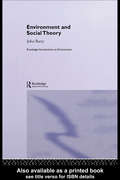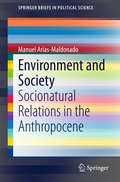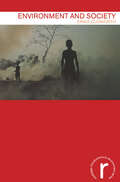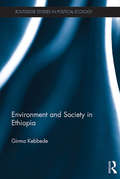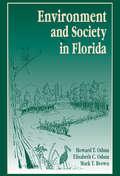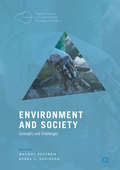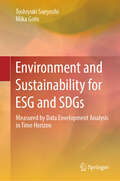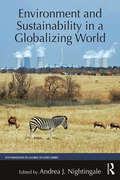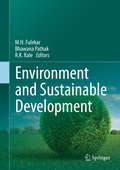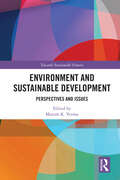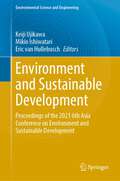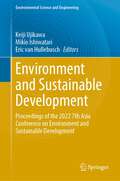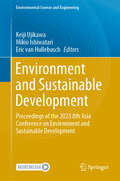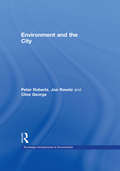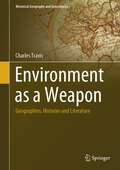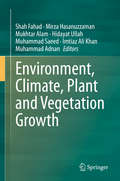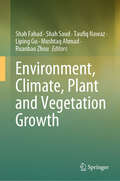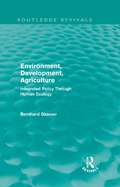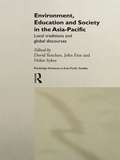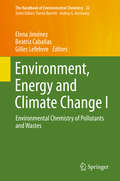- Table View
- List View
Environment and Social Theory
by John BarryWritten in an accessible and jargon-free way, Environment and Social Theory examines: * the historical relationship between social theory and the environment *pre-Enlightenment and Enlightenment social theory and the environment * twentieth century social theory and the environment * economic theory and the environment * the relationship between ecology, biology and social theory * recent theoretical approaches to the environment * the development of a green social theory The ideas and vies of key theorists including Hobbes, Locke, freud, Habermas, Giddens and Beck are discussed to provide comprehensive coverage of social theory for non-specialist readers.
Environment and Social Theory (Routledge Introductions to Environment: Environment and Society Texts)
by John BarryWritten in an engaging and accessible manner by one of the leading scholars in his field, Environment and Social Theory, completed revised and updated with two new chapters, is an indispensable guide to the way in which the environment and social theory relate to one another. This popular text outlines the complex interlinking of the environment, nature and social theory from ancient and pre-modern thinking to contemporary social theorizing. John Barry: examines the ways major religions such as Judaeo-Christianity have and continue to conceptualize the environment analyzes the way the non-human environment features in Western thinking from Marx and Darwin, to Freud and Horkheimer explores the relationship between gender and the environment, postmodernism and risk society schools of thought, and the contemporary ideology of orthodox economic thinking in social theorising about the environment. How humans value, use and think about the environment, is an increasingly central and important aspect of recent social theory. It has become clear that the present generation is faced with a series of unique environmental dilemmas, largely unprecedented in human history. With summary points, illustrative examples, glossary and further reading sections this invaluable resource will benefit anyone with an interest in environmentalism, politics, sociology, geography, development studies and environmental and ecological economics.
Environment and Society
by Manuel Arias-MaldonadoThis short book sets out to explore the concept of nature in the context of a changing reality, in which the extent of our transformation of the environment has become evident: What is nature and to what extent has humanity transformed it? How do nature and society relate to one another? What does the idea of a sustainable society entail and how can nature be understood as a political subject? What is the Anthropocene and how does it affect nature as both an idea and a material entity? Has nature perhaps "ended?" In addressing these questions, the author delivers a concise but meaningful study of contemporary understandings of nature, one that goes beyond the limits posed by a single discipline. Adopting a truly comprehensive perspective, the work incorporates classical disciplines such as philosophy, evolutionary theory and the history of ideas; new and mixed approaches ranging from environmental sociology to neurobiology and ecological economics and the emerging area of the environmental humanities and represents a growing branch of political thought that views nature as a new political subject.
Environment and Society (Routledge Introductions to Environment: Environment and Society Texts)
by Erika CudworthAt the start of the twenty-first century, it can be argued that human societies have a greater impact on the environment than ever before. We have always been dependent upon, and interacted with, the 'natural' environment. However, the dramatic social changes of the past three centuries, have altered the form of our relationship with non-human nature to the extent that some would see people/planet relations as in a situation of crisis.Environment and Society provides a comprehensive and critical account of the ways in which we can think about the relationship between human societies and the environments with which they interact. It argues that human societies are ecologically embedded, and that environments are often socially embedded and constituted. It makes the different theoretical positions and empirical studies accessible to students, and includes chapter outlines and summaries, annotated further reading, boxed case-studies and discussion points.
Environment and Society in Ethiopia (Routledge Studies in Political Ecology)
by Girma KebbedeEthiopia is facing environmental and poverty challenges, and urgently needs effective management of its environmental resources. Much of the Ethiopian landscape has been significantly altered and reshaped by centuries of human activities, and three-quarters of the rural population is living on degraded land. Over the past two decades the country has seen rapid economic and population growth and unparalleled land use change. This book explores the challenges of sustaining the resource base while fuelling the economy and providing for a growing population that is greatly dependent on natural resources for income and livelihoods. Adopting a political ecology perspective, this book comprehensively examines human impacts on the environment in Ethiopia, defining the environment both in terms of the quantity and quality of renewable and non-renewable natural resources. With high levels of economic production and consumption also come unintended side effects: waste discharges, emissions of pollutants, and industrial effluents. These pollutants can degrade the quality of water, air, land, and forests as well as harm the health of people, animals, and other living organisms if untreated or disposed of improperly. This book demonstrates how the relationship between society and environment is inherently and delicately interwoven, providing an account of Ethiopia’s current environment and natural resource base and future considerations for environmentally sustainable development.
Environment and Society in Florida
by Howard T. OdumWith its lush wetlands, miles of beaches, and wide array of colorful wildlife, Florida is a fascinating and important ecosystem to study. Using this state as a model, Environment and Society in Florida offers a whole systems approach to understanding the environment and discusses the interactions between human systems and natural systems. It addresses the complicated issues stemming from these interactions among population, resources, economics, and environment, and discusses how we may better manage these challenges in the future.
Environment and Society: A Reader
by Colin Jerolmack Anne Rademacher Christopher Schlottmann Dale Jamieson Maria DamonEnvironment and Society connects the core themes of environmental studies to the urgent issues and debates of the twenty-first century. In an era marked by climate change, rapid urbanization, and resource scarcity, environmental studies has emerged as a crucial arena of study. Assembling canonical and contemporary texts, this volume presents a systematic survey of concepts and issues central to the environment in society, such as: social mobilization on behalf of environmental objectives; the relationships between human population, economic growth and stresses on the planet’s natural resources; debates about the relative effects of collective and individual action; and unequal distribution of the social costs of environmental degradation. Organized around key themes, with each section featuring questions for debate and suggestions for further reading, the book introduces students to the history of environmental studies, and demonstrates how the field’s interdisciplinary approach uniquely engages the essential issues of the present.
Environment and Society: Concepts and Challenges (Palgrave Studies in Environmental Sociology and Policy)
by Debra J. Davidson Magnus BoströmThis book offers a critical analysis of core concepts that have influenced contemporary conversations about environment-society relations in academic, political, and civil circles. Considering these conceptualizations are currently shaping responses to environmental crises in fundamental ways, critical reflections on concepts such as the Anthropocene, metabolism, risk, resilience, environmental governance, environmental justice and others, are well-warranted. Contributors to this volume, working across a multitude of areas within environmental social science, scrutinize underlying worldviews and assumptions, asking a common set of key questions: What are the different concepts able to explain? How do they take into account society-environment relations? What social, cultural, or geo-political biases and blinders are inherent? What actions or practices do the concepts inspire? The transdisciplinary engagement and reflexivity regarding concepts of environment-society relations represented in these chapters is needed in all spheres of society—in academia, policy and practice—not the least to confront current tendencies of anti-reflexivity and denialism.
Environment and Sustainability for ESG and SDGs: Measured by Data Envelopment Analysis in Time Horizon
by Toshiyuki Sueyoshi Mika GotoThis book takes a non-parametric approach to analyze integrated measures of economic growth, energy use, and sustainability. Recently, many corporate leaders, policymakers, organizations, and individuals have become concerned about environmental issues, simultaneously paying attention to economic prosperity and the green growth of the economy. This book combines methodology and application. Methodologically, the book introduces non-parametric approaches—for instance, data envelopment analysis–discriminant analysis (DEA-DA) and data envelopment analysis–environmental assessment (DEA-EA). From a practical perspective, the book provides readers such as researchers and graduate students with models under the proposed non-parametric analytical frameworks and examines environmental issues and economic development. Included are application studies of these approaches using national-, regional-, and corporate-level datasets. Also discussed are policy implications and future directions of sustainable development based on empirical results.
Environment and Sustainability in a Globalizing World (Foundations in Global Studies)
by Andrea J. NightingaleFrom the Foundations in Global Studies series, this student-friendly text follows a two-pronged approach to help readers understand the globalizing processes relating to environment and sustainability, which are examined in a range of disciplines, including environmental studies, geography, global studies, political science, international affairs, comparative politics, and other disciplines. First, it presents foundational material that gives students the conceptual underpinnings required for rigorous analysis. Following the Introduction and Overview, Part One presents a brief historical overview of the concerns revolving around environmental sustainability in the modern era. The text then covers key concepts and theoretical constructs that define the global context for sustainable environmental practices, such as the key thinkers and theories pertaining to sustainable environmental practice, and the key international agencies and treaties involved in global discussions. The first part then explores the various models and ways to measure sustainability, the range of environmental domains at play in the sustainability dialogue, and the controversies surrounding them. Part Two employs case studies to examine theory and practice at work in particular situations. The case studies have been selected with an eye toward comprehensiveness of coverage across disciplines and across regions.
Environment and Sustainable Development
by M. H. Fulekar Bhawana Pathak R K KaleGlobal society in the 21st century is facing challenges of improving the quality of air, water, soil and the environment and maintaining the ecological balance. Environmental pollution, thus, has become a major global concern. The modern growth of industrialization, urbanization, modern agricultural development and energy generation has resulted in the indiscriminate exploitation of natural resources for fulfilling human desires and needs, which has contributed in disturbing the ecological balance on which the quality of our environment depends. Human beings, in the truest sense, are the product of their environment. The man-environment relationship indicates that pollution and deterioration of the environment have a social origin. The modern technological advancements in chemical processes/operations have generated new products, resulting in new pollutants in such abundant levels that they are above the self-cleaning capacity of the environment. One of the major issues in recent times is the threat tohuman lives due to the progressive deterioration of the environment from various sources. The impact of the pollutants on the environment will be significant when the accumulated pollutants load will exceed the carrying capacity of the receiving environment. Sustainable development envisages the use of natural resources, such as forests, land, water and fisheries, in a sustainable manner without causing changes in our natural world. The Rio de Janeiro-Earth Summit, held in Brazil in 1992, focused on sustainable development to encourage respect and concern for the use of natural resources in a sustainable manner for the protection of the environment. This book will be beneficial as a source of educational material to post-graduate research scholars, teachers and industrial personnel for maintaining the balance in the use of natural sources for sustainable development.
Environment and Sustainable Development: Perspectives and Issues (Towards Sustainable Futures)
by Manish K. VermaThis volume provides a comprehensive account of the linkages between environment and sustainable development in society from an interdisciplinary perspective. With its case studies from across the world, including countries such as India, Australia, South Africa, Sri Lanka, the United States, Croatia, Italy, Brazil, Japan, and Kenya, it explores critical environmental issues concerning energy justice, queer ecology, mountain cultures, incarceration, energy strategies, mining tourism, pollution control mechanisms, social impacts of oil and gas production, contract farming, gender mainstreaming, climate change, and droughts and adaptation strategies along with literacy, leisure, well-being, development, sexuality, sustainability and environmental education. The book examines several dimensions within global environment of the adverse impact of developmental activities, discusses sustainable development activities undertaken in contemporary times, and underscores the importance of a just, people-centric policy framework in promoting sustainable development. Lucid and topical, this book will be useful to scholars and researchers of environmental studies, development studies, sustainable development, political studies, sociology, and political economy. It will also interest policymakers, development practitioners, NGOs and think tanks working on environment and sustainable development, climate issues and SDGs.
Environment and Sustainable Development: Proceedings of the 2021 6th Asia Conference on Environment and Sustainable Development (Environmental Science and Engineering)
by Mikio Ishiwatari Keiji Ujikawa Eric Van HullebuschThis book collects the latest advances, innovations, and applications in the field of environmental science and sustainable development, which were presented by scholars and researchers at the 2021 6th Asia Conference on Environment and Sustainable Development, held in Phuket, Thailand, November 6–8, 2021. The book covers highly diverse topics, including environmental dynamics, global environmental change and ecosystems management, environmental restoration and ecological engineering, water treatment and reclamation, environmental sustainability, health and the environment, wastewater and sludge treatment, solid waste management, air pollution and control. The contributions, which were selected in a rigorous international peer-review process, highlight numerous exciting ideas that will spur novel research directions and foster multidisciplinary collaborations.
Environment and Sustainable Development: Proceedings of the 2022 7th Asia Conference on Environment and Sustainable Development (Environmental Science and Engineering)
by Mikio Ishiwatari Keiji Ujikawa Eric Van HullebuschThis book presents selected papers from the 2022 7th Asia Conference on Environment and Sustainable Development, which was held in Kyoto, Japan, November 4–6, 2022. The event was co-sponsored by the International Network for Environmental and Humanitarian Cooperation, and technically supported by Yokohama National University and the National Institute for Environmental Studies, Japan. The book focuses on environmental restoration and ecological engineering, global environmental change and ecosystems management, environmental dynamics, wastewater and sludge treatment, air pollution and control, and environmental sustainability. The volume is a valuable resource for those in both academia and industry.
Environment and Sustainable Development: Proceedings of the 2023 8th Asia Conference on Environment and Sustainable Development (Environmental Science and Engineering)
by Mikio Ishiwatari Keiji Ujikawa Eric Van HullebuschThis book is a collection of selected, peer-reviewed papers presented at the 2023 8th Asia Conference on Environment and Sustainable Development (ACESD), held in Sapporo, Japan, November 3–5, 2023. The ACESD is held annually to provide a forum for researchers, practitioners, and professionals from industries, academia, and governments to discuss research, development, and professional practice in environmental and sustainable development. The book covers diverse topics, including environmental dynamics, global environmental change and ecosystems management, environmental restoration and ecological engineering, water treatment and reclamation, solid waste management, environmental sustainability, and air pollution and control. The book highlights numerous innovative ideas that will spur novel research directions and is a valuable resource for researchers and professionals working in these fields.
Environment and Tourism (2nd Edition)
by Andrew HoldenThis second edition of Environment and Tourism reflects changes in the relationship between tourism, society and the natural environment in the first decade of the new century. Alongside the updating of all statistics, environmental policy initiatives, examples and case studies new material has been added. This includes two new chapters: one on climate change and natural disasters and the other on the relationship between tourism and poverty. These themes have direct relevance, not only to tourism, but are reflective of the wider relationship between nature and society, a thesis that contextualizes this book. Tourism is also analyzed as an interconnected system, linking the environments of where tourists come from, with the ones they go to. Taking a holistic view of the tourism system and how it interacts with the natural environment, this volume illustrates the positive and negative effects of this relationship, and importantly how tourism can be planned and managed to encourage natural resource conservation and aid human development. It is an invaluable tool for all those studying human geography, tourism and environment studies.
Environment and the City (Routledge Introductions to Environment: Environment and Society Texts)
by Clive George Joe Ravetz Joe Howe Peter W. RobertsFor the first time at the beginning of the twenty-first century, urban dwellers outnumber rural residents and this trend is set to continue. Consequently one of the most pressing issues of our time is how to square the social and economic development of cities with their environmental limits and those of the wider environment. The theme of the environment and city is topical at every level, from the politics of global trade to local community networks. Environment and the City looks at the evolution of cities in the developed and the developing world and the implications for resource consumption and environmental impacts. It takes a cross-cutting approach with new thinking on multiple geographies – the configuration of networks, exclusion, consumption, risk and ecological footprint. Urban environmental themes and their related social, economic and political agendas are outlined. In turn the environmental impacts and environmental agendas relating to key sectors of the urban economy are discussed. The global context to such issues is then explored before the practical tools and methods of urban environmental management are investigated. The theme of the sustainable city emerges from this – not so much as a standard menu, but as a learning process between all sections of society. This book, a valuable resource, provides a concise, accessible route map for all students interested in the environmental issues emanating from our urban society. Written to aid student understanding, the easily navigable text features boxed practical examples, discussion points, signposts to reading and websites, and a glossary.
Environment as a Weapon: Geographies, Histories and Literature (Historical Geography and Geosciences)
by Charles TravisEnvironment as a Weapon considers how the confluence of war and nature from the time of the Agricultural Revolution (10,000 BCE) to our present day has been represented in works of history, geography, and literature. In the Epic of Gilgamesh, the Torah and Greco-Roman myths, warfare is a trope commensurate with environmental disasters, extreme climate, and plague. In the medieval age myths the Táin, and Beowulf environments become allies and enemies. The equestrian steppeland as foundation of Genghis Khan’s and his heirs Pax Mongolica is chronicled in The Secret History of the Mongols and The Travels of Marco Polo. The West African Griot legend of Sundiata and the Little Ice Age wreck of the Spanish Armada in 1588 speak to oceanic and atmospheric dimensions of warfare. American Revolution political pamphlets, poetry, diaries and weather logs, reflect the severe weather and terrain deployed by George Washington’s early campaigns in the war of independence. Napoleon’s midwifing of Total War is captured in Mary Shelley’s Frankenstein, Leo Tolstoy’s War and Peace, and Charles Minard’s Carte figurative carto-graph of the disastrous 1812 French invasion of Russia. The U.S. Civil War and the organic-industrial assembles of its battles, arguably the first Anthropocene War, is parsed by the clarifying poetry of Emily Dickinson. Geopolitik and geo-hazards of flood and fire feature in the Global War works of Samuel Beckett, Kurt Vonnegut and James Dickey. The literature of Vietnamese and American war combat veterans reveals how North Vietnam’s Environmental Military Complex stalled the American Military Industrial Complex in the jungles, and R&R districts of southwestern Asia. Finally, he sci-fi of H.G. Wells’ World Set Free and David Mitchell’s Cloud-Atlas frame Oppenheimer’s sub-atomic deployments at Hiroshima and Nagasaki, James Lovelock’s ‘Gaia’ and U.S. military discourses situating global warming as a national security threat to America. Indeed, Environment and War ironically resonates with U.N. Secretary General António Guterres proclamation that “seventy-five years ago, the world emerged from a series of cataclysmic events: two successive world wars, genocide, a devastating influenza pandemic . . . Our founders gathered in San Francisco promising to save succeeding generations from the scourge of war.” Thus, a holistic approach to studying and mitigating the human and environmental impacts of warfare, must integrate methods from the arts, humanities and sciences. This involves understanding how the historical geographies of the Earth’s planetary systems have been perceived, deployed and emerged as agents of warfare, with the lithosphere, hydrosphere, cryosphere, biosphere and atmosphere transformed as arsenals against anthropogenic global warming. This book will be of interest to geographers, historians, and scholars in environmental studies, climate change, literature and military studies, as well as the broader environmental humanities.
Environment, Climate, Plant and Vegetation Growth
by Mirza Hasanuzzaman Shah Fahad Mukhtar Alam Hidayat Ullah Muhammad Saeed Imtiaz Ali Khan Muhammad AdnanThis book provides an up-to-date account of the current understanding of climate change and global warming related to environment, climate, plant and vegetation growth. The aim of this book is to provide a platform for scientists and academics world-wide to promote, share, and discuss various new issues and developments in the area of plant and vegetation growth related to climate change. Over the next decades, it is predicted that billions of people, particularly those in developing countries, face shortages of water and food and greater risks to health and life as a result of climate change. Concerted global action is needed to enable developing countries to adapt to the effects of climate change that are happening now and will worsen in the future. The book will also enhance the understanding on issues related to climate change, giving a clear indication of a looming global warming crisis. Addressing global climate change is a monumental battle that can only be fought by the leaders of tomorrow, but future leaders are molded through education and shaped by the leaders of today.
Environment, Climate, Plant and Vegetation Growth
by Mushtaq Ahmad Shah Fahad Shah Saud Taufiq Nawaz Liping Gu Ruanbao ZhouThe book provides currently available information on the changing climate and its impact on functional and adaptive features of plants. The book also cover cutting edge research on key determinants of plant growththat provides a direction towards execution of programs and practices that will assist resilience of crop production systems to the changing climate. This book will represent the updated scientific information regarding soil and plant productivity under changing climate which will be beneficial to academics and researchers working on climate change, agronomy, stress physiology, biotechnology. It provides an in-depth discussion on the latest techniques to enhance plant responses to new environmental conditions that can be directly applied on field.
Environment, Development, Agriculture: Integrated Policy Through Human Ecology (Routledge Revivals)
by Bernhard GlaeserThis reissue, first published in 1995, focuses on philosophy and social science in human ecology, and includes case studies dealing with the problems of political implementation of development plans and schemes. Part One deals with theory, including a comprehensive introduction to the field and an overview of the conceptual modelling typical in human ecology. Part Two moves towards questions of human behaviour and action, exploring the relationship between environmental ethics and policy in terms of the justification and implementation of human interactions with nature and the environment on an ecologically sustainable basis. In Part Three, the author focuses on environmental policy in China since 1949 and on a regional case study in India. The final part of the book discusses the prospects for sustainable development more broadly, in terms of favouring ecological and cultural variety in agriculture and of viewing the relationship between human beings and the natural environment as a matter of overexploitation rather than crisis.
Environment, Education and Society in the Asia-Pacific: Local Traditions and Global Discourses (Routledge Advances in Asia-Pacific Studies #Vol. 1)
by John Fien David Yencken Helen SykesThis important book explores the interaction of global environmental discourses and local traditions and practices in twelve countries in the Asia-Pacific region. Based upon two parallel groups of studies, reviewing cultural influences in individual countries, and the attitudes of young people across the region, it has important implications for environmental policy and education.
Environment, Energy and Climate Change II
by Gilles Lefebvre Elena Jiménez Beatriz CabañasThis volume provides a comprehensive overview of advanced research in the field of efficient, clean and renewable energy production, conversion and storage. The ten chapters, written by internationally respected experts, address the following topics: (1) solar and wind energy; (2) energy storage in batteries; (3) biomass; and (4) socio-economic aspects of energy. Given its multidisciplinary approach, which combines environmental analysis and an engineering perspective, the book offers a valuable resource for all researchers and students interested in environmentally sustainable energy production, conversion, storage and its engineering.
Environment, Growth and Development: The Concepts and Strategies of Sustainability
by Peter BartelmusFirst Published in 2004. Environment, Growth and Development offers a unique analysis of sustainable economic growth and development and the implications for policy and planning at the local, national and global scale.
Environment, Health and History
by Virginia Berridge Martin GorskyThe environment is currently a matter of international public and academic concern, but is often considered separately from health issues. This book brings together work from environmental and health historians to conceptualise the connection between environment and health at different times and in different geographical locations.
